IOW, The Good, The Bad and The Ugly. Here below is a comparison of the results of both procedures, to the left SXT and to the right SN++ 2, both used in PI 1.8-9. Test image in linear state here auto-stretched by PI in the same manner: 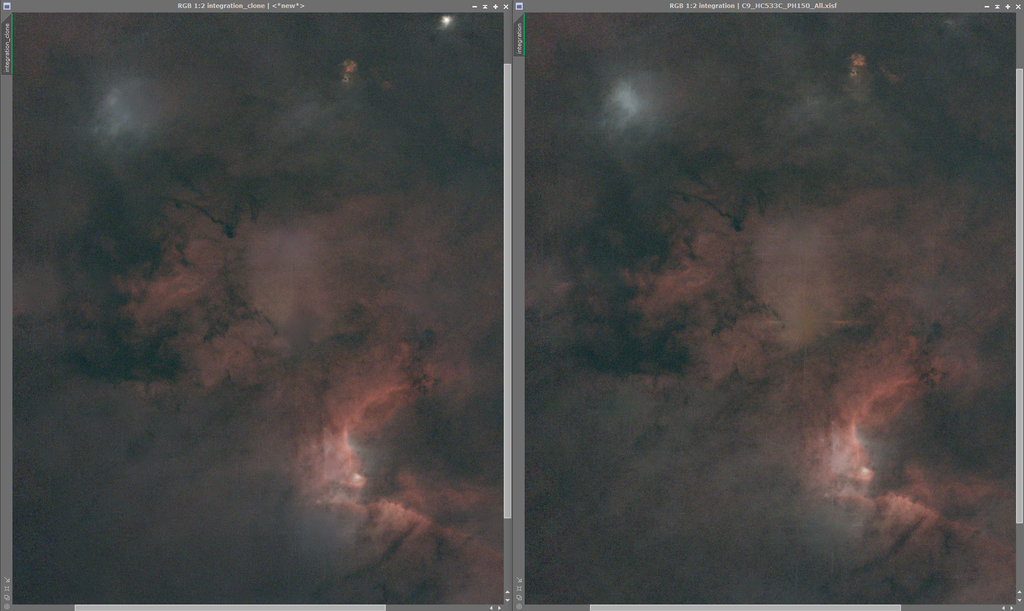 Comparing them side by side is easily seen that: 1. SXT removes A LOT of faint nebulosity with the star mask 2. SXT applies a low-pass filter to the tail of the histogram thus wiping faint large-scale details 3. SXT removes nearly all the diffraction artefacts caused by the specific exit pupil, here clips and spider spikes 4. SN++ V2 preserves the original faint details A LOT better in the starless image 5. It also does not apply a low-pass filter to pamper over leftover artefacts thus preserving large scale faint details 6. SN++ V2 is also more agressive in removing small, bright nebulae closely associated with a star, while SXT does not (but will still remove fainter ones) Bottom line: neither is perfect but SN++ V2 ought to be preferred in similar circumstances or better still, process the image as a whole.
|
You cannot like this item. Reason: "ANONYMOUS".
You cannot remove your like from this item.
Editing a post is only allowed within 24 hours after creating it.
You cannot Like this post because the topic is closed.
Copy the URL below to share a direct link to this post.
This post cannot be edited using the classic forums editor.
To edit this post, please enable the "New forums experience" in your settings.
The SN++ image looks like a superior result here when viewing subjectively. Nice comparison.
One thing for sure, is that each of these softwares seems to really spur refinement and development in the other. It's amazing how much both have progressed since their inception.
|
You cannot like this item. Reason: "ANONYMOUS".
You cannot remove your like from this item.
Editing a post is only allowed within 24 hours after creating it.
You cannot Like this post because the topic is closed.
Copy the URL below to share a direct link to this post.
This post cannot be edited using the classic forums editor.
To edit this post, please enable the "New forums experience" in your settings.
Thanks for sharing this @andrea tasselli. Coincidentally, I just installed Starnet++ V2 a few days ago and came to similar conclusions as your bullet points after having used SXT for a long time. I like your suggestion of processing images as a whole, but that isn’t always possible. My thinking was to prepare two sets of starless images, one with SN++ V2 and the other with SXT, and selectively combine the best bits of each. This is probably what I will end up doing. Ani
|
You cannot like this item. Reason: "ANONYMOUS".
You cannot remove your like from this item.
Editing a post is only allowed within 24 hours after creating it.
You cannot Like this post because the topic is closed.
Copy the URL below to share a direct link to this post.
This post cannot be edited using the classic forums editor.
To edit this post, please enable the "New forums experience" in your settings.
Ani Shastry:
I like your suggestion of processing images as a whole, but that isn’t always possible. My thinking was to prepare two sets of starless images, one with SN++ V2 and the other with SXT, and selectively combine the best bits of each. This is probably what I will end up doing. Agree. If you have something like an Epsilon and any bright stars, StarNet becomes almost unusable since it leaves huge artifacts due to the bright stars and diffraction spikes. It does better with the faint stuff than SXT does but with a fast scope the faint stuff often comes with the bright stars due to the speed. So a bit of a conflict there. For the time being using both with some creative image combination seems the way to go....
|
You cannot like this item. Reason: "ANONYMOUS".
You cannot remove your like from this item.
Editing a post is only allowed within 24 hours after creating it.
You cannot Like this post because the topic is closed.
Copy the URL below to share a direct link to this post.
This post cannot be edited using the classic forums editor.
To edit this post, please enable the "New forums experience" in your settings.
Just processing a new object and noted that (used linear) SXT was wiping some very significant detail that Starnet did not. My take is that if there are no bright stars, Starnet is superior at this point.. (Ha on the moth nebula no other processing, just combine and Star Removal). StarNet on the right. FYI, I also tried SXT on a stretched version and it did the same thing... 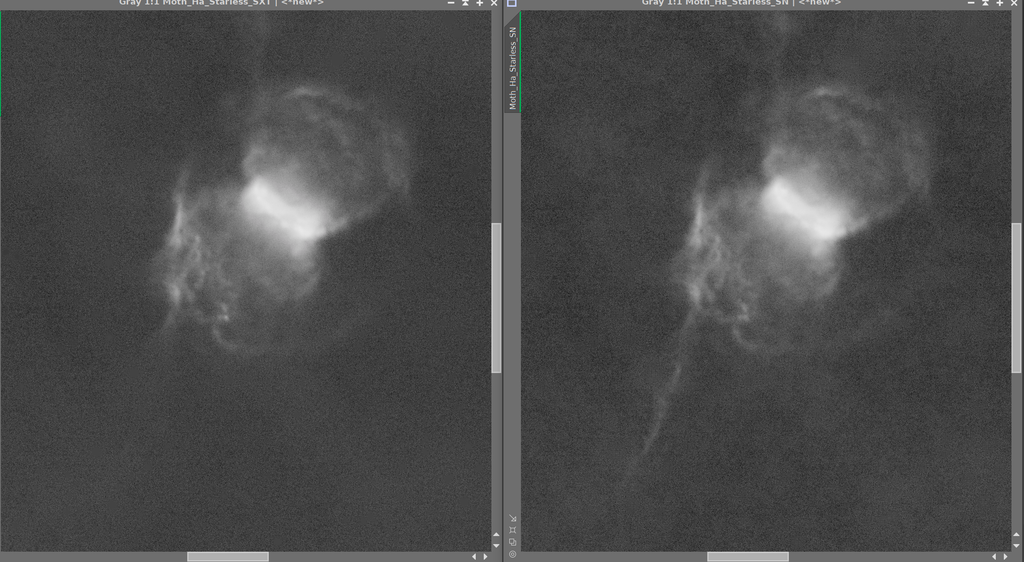 |
You cannot like this item. Reason: "ANONYMOUS".
You cannot remove your like from this item.
Editing a post is only allowed within 24 hours after creating it.
You cannot Like this post because the topic is closed.
Copy the URL below to share a direct link to this post.
This post cannot be edited using the classic forums editor.
To edit this post, please enable the "New forums experience" in your settings.
Yikes! That is pretty terrible! What is it like if you stretch the images and run the same comparison?
|
You cannot like this item. Reason: "ANONYMOUS".
You cannot remove your like from this item.
Editing a post is only allowed within 24 hours after creating it.
You cannot Like this post because the topic is closed.
Copy the URL below to share a direct link to this post.
This post cannot be edited using the classic forums editor.
To edit this post, please enable the "New forums experience" in your settings.
Stretched with basic histo stretch first gives basically the same result, at least on SXT - did not try it with StarNet since that was OK as is…
|
You cannot like this item. Reason: "ANONYMOUS".
You cannot remove your like from this item.
Editing a post is only allowed within 24 hours after creating it.
You cannot Like this post because the topic is closed.
Copy the URL below to share a direct link to this post.
This post cannot be edited using the classic forums editor.
To edit this post, please enable the "New forums experience" in your settings.
A word a caution with SN++; if stretching the whole image and then removing the stretched stars SN will dim the star mask considerably (basically flattens the high part of the histogram) and won't return the image to its original state. Haven't yet found a cure for this other than acting on the star mask histogram and bring back the brightness distribution again, by eyeballing it.
|
You cannot like this item. Reason: "ANONYMOUS".
You cannot remove your like from this item.
Editing a post is only allowed within 24 hours after creating it.
You cannot Like this post because the topic is closed.
Copy the URL below to share a direct link to this post.
This post cannot be edited using the classic forums editor.
To edit this post, please enable the "New forums experience" in your settings.
Damn. Thanks for circling back @Bill. Might be a good idea to share your example with Russell so he can augment his ML training dataset.
|
You cannot like this item. Reason: "ANONYMOUS".
You cannot remove your like from this item.
Editing a post is only allowed within 24 hours after creating it.
You cannot Like this post because the topic is closed.
Copy the URL below to share a direct link to this post.
This post cannot be edited using the classic forums editor.
To edit this post, please enable the "New forums experience" in your settings.
Ani Shastry:
Damn. Thanks for circling back @Bill. Might be a good idea to share your example with Russell so he can augment his ML training dataset. Actually it is thanks to Andrea and this thread that I decided to compare them when I set out to process the object today.  I had expected some difference but not that much... I have sent Russ a link to this thread so he can be aware and comment/make suggestions/make changes as is required.
|
You cannot like this item. Reason: "ANONYMOUS".
You cannot remove your like from this item.
Editing a post is only allowed within 24 hours after creating it.
You cannot Like this post because the topic is closed.
Copy the URL below to share a direct link to this post.
This post cannot be edited using the classic forums editor.
To edit this post, please enable the "New forums experience" in your settings.
Have you done tests using various combinations of settings in SXT as well? Like large overlap on or off, upsampling/drizzling and downsampling afterwards using the lite version?
I haven't done any side by side testing with Starnet as I stopped using it a long time ago, so that's interesting to see. I do however have different results by using different settings and the upsample/downsample solution I mentioned.
|
You cannot like this item. Reason: "ANONYMOUS".
You cannot remove your like from this item.
Editing a post is only allowed within 24 hours after creating it.
You cannot Like this post because the topic is closed.
Copy the URL below to share a direct link to this post.
This post cannot be edited using the classic forums editor.
To edit this post, please enable the "New forums experience" in your settings.
Have you done tests using various combinations of settings in SXT as well? Like large overlap on or off, upsampling/drizzling and downsampling afterwards using the lite version?
I haven't done any side by side testing with Starnet as I stopped using it a long time ago, so that's interesting to see. I do however have different results by using different settings and the upsample/downsample solution I mentioned. Large overlap settings make no difference and I don't drizzle at my focal length as it is already oversampled...
|
You cannot like this item. Reason: "ANONYMOUS".
You cannot remove your like from this item.
Editing a post is only allowed within 24 hours after creating it.
You cannot Like this post because the topic is closed.
Copy the URL below to share a direct link to this post.
This post cannot be edited using the classic forums editor.
To edit this post, please enable the "New forums experience" in your settings.
Bill McLaughlin:
Large overlap settings make no difference and I don't drizzle at my focal length as it is already oversampled... The general idea about upscaling images before performing SXT and other necessities beforehand has nothing to do with being well sampled. It's just a matter of giving SXT a better foundation to work from. At least my experience is that a lot more of smaller details, like galaxies, were left untouched by doing so. Then downsampling the data back again afterwards to regain the original aspect and SNR ratio. In some cases the lite version has worked a bit better as well. The various AI variants will affect the image differently, which is why it would be interesting to see direct comparisons. They are perhaps a bit under-documented by RC on his site, but I believe they are described within PI itself as well. As for the large overlap setting I find that it gives a huge benefit as not using it has, at times, given me lots of square box artifacts. The reason is as stated in the documentation that it has a 50% overlap between tiles in stead of 20%. I've not tested how the larger overlap individually affect images though. I might be able to provide these tests myself within a day or so.
|
You cannot like this item. Reason: "ANONYMOUS".
You cannot remove your like from this item.
Editing a post is only allowed within 24 hours after creating it.
You cannot Like this post because the topic is closed.
Copy the URL below to share a direct link to this post.
This post cannot be edited using the classic forums editor.
To edit this post, please enable the "New forums experience" in your settings.
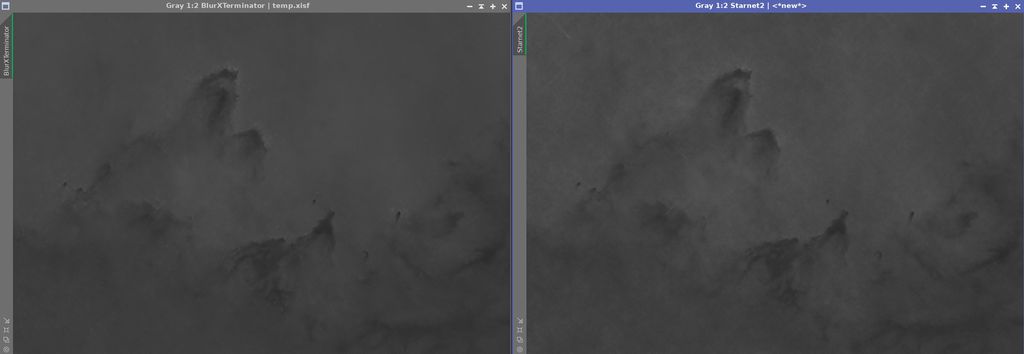 Same observation here, E-160ed @530mm F3.3, drizzle x2, linear, crop, STF; very dense star field. SXT left, SN++ right. StarXTerminator seems to deal better with spikes, looks smoother, but a lot of the fainter background texture is somewhat lost. In a way Starnet looks livelier / less artifical.
|
You cannot like this item. Reason: "ANONYMOUS".
You cannot remove your like from this item.
Editing a post is only allowed within 24 hours after creating it.
You cannot Like this post because the topic is closed.
Copy the URL below to share a direct link to this post.
This post cannot be edited using the classic forums editor.
To edit this post, please enable the "New forums experience" in your settings.
Bill McLaughlin:
Just processing a new object and noted that (used linear) SXT was wiping some very significant detail that Starnet did not. My take is that if there are no bright stars, Starnet is superior at this point.. (Ha on the moth nebula no other processing, just combine and Star Removal). StarNet on the right.
FYI, I also tried SXT on a stretched version and it did the same thing...
 Hi Bill, are you talking about structure in the moth itself, or in the area surrounding the moth? I wonder if what we are seeing here in the area around the moth is better mottling management with StarX?
|
You cannot like this item. Reason: "ANONYMOUS".
You cannot remove your like from this item.
Editing a post is only allowed within 24 hours after creating it.
You cannot Like this post because the topic is closed.
Copy the URL below to share a direct link to this post.
This post cannot be edited using the classic forums editor.
To edit this post, please enable the "New forums experience" in your settings.
@Bill McLaughlin nevermind... I see that StarX wiped out that long filament at the bottom of the moth. Didnt catch that at first glance... Thats undesirable for sure!
|
You cannot like this item. Reason: "ANONYMOUS".
You cannot remove your like from this item.
Editing a post is only allowed within 24 hours after creating it.
You cannot Like this post because the topic is closed.
Copy the URL below to share a direct link to this post.
This post cannot be edited using the classic forums editor.
To edit this post, please enable the "New forums experience" in your settings.
This is a tough one. I just compared Starnet2 to StarX on a widefield image I'm working on. StarX did a vastly superior job at removing brighter stars and having fewer artifacts. You can clearly see that it is somewhat detrimental to the fainter filamentary dusty structure in the image. On the other end, Starnet nuked many of the tiny little background galaxies while StarX left them in the image.
From an overall aesthetic, I think StarX is doing a better job even if it's messing with some structure. I find the artifacts left behind where bright stars are removed by Starnet to be much more distracting than the differences that need to be observed at 1:1 or 2:1 pixel peeping.
A very interesting conversation for sure.
|
You cannot like this item. Reason: "ANONYMOUS".
You cannot remove your like from this item.
Editing a post is only allowed within 24 hours after creating it.
You cannot Like this post because the topic is closed.
Copy the URL below to share a direct link to this post.
This post cannot be edited using the classic forums editor.
To edit this post, please enable the "New forums experience" in your settings.
To be fair to SN2, upsampling my test image having a dozen of them galaxies leaves all but the smallest ones in the starless image while SXT leaves just the brightest 3. Go figure. I'm sticking with SN++ with linear imagery.
|
You cannot like this item. Reason: "ANONYMOUS".
You cannot remove your like from this item.
Editing a post is only allowed within 24 hours after creating it.
You cannot Like this post because the topic is closed.
Copy the URL below to share a direct link to this post.
This post cannot be edited using the classic forums editor.
To edit this post, please enable the "New forums experience" in your settings.
andrea tasselli:
To be fair to SN2, upsampling my test image having a dozen of them galaxies leaves all but the smallest ones in the starless image while SXT leaves just the brightest 3. Go figure. I'm sticking with SN++ with linear imagery. I havent tried the upsampling feature. I'll give that a try.
|
You cannot like this item. Reason: "ANONYMOUS".
You cannot remove your like from this item.
Editing a post is only allowed within 24 hours after creating it.
You cannot Like this post because the topic is closed.
Copy the URL below to share a direct link to this post.
This post cannot be edited using the classic forums editor.
To edit this post, please enable the "New forums experience" in your settings.
I have seen many SXT vs StarNet++ posts. This is the only one that hits the target, I think.
Small galaxies are always problematic. Even professional astronomers have hard times developing algorithms to automatically separate stars from small galaxies (or compact nebula knots) when there is just an image and no additional information. So I wouldn't use small galaxies to judge either of the programs.
I tried SXT in a trial and then quickly gave up. I found lot of strange artifacts after I added stars back to the starless image processed from the SXT result. I examined the "star" image (original minus SXT starless) and found lots of faint features other than just stars. If I directly add this star image to the SXT starless image, of course I recover the original. But if I add the star image to a stretched (or however processed) SXT starless image, those artifact shows up. I think this is the same thing found by Andrea in the original post: SXT does not just remove stars.
On the other hand, one can try to stretch the star image produced by starnet (original - starnet starless). The result will be very clean: pure black background and stars, (almost) no other faint features. This allows to process the starless image and to add stars back without introducing artifacts. Because of this, starnet is my only go-to program when I need to separate stars and nebulas. Even if some stars are missed or some galaxies are removed, this wouldn't lead to an unpleasant final result.
|
You cannot like this item. Reason: "ANONYMOUS".
You cannot remove your like from this item.
Editing a post is only allowed within 24 hours after creating it.
You cannot Like this post because the topic is closed.
Copy the URL below to share a direct link to this post.
This post cannot be edited using the classic forums editor.
To edit this post, please enable the "New forums experience" in your settings.
Chris White- Overcast Observatory:
Hi Bill, are you talking about structure in the moth itself, or in the area surrounding the moth? I wonder if what we are seeing here in the area around the moth is better mottling management with StarX? Both really, but especially the "arm" that extends off the bottom of the nebula. Very real in the starry image but just gone in the SXT version. The area further out (cropped out here) also has quite a bit of dim Ha that is pretty noisy but that is preserved better as well in the Starnet version, although it may be too noisy and dim to be useful in a practical sense in the final image.
|
You cannot like this item. Reason: "ANONYMOUS".
You cannot remove your like from this item.
Editing a post is only allowed within 24 hours after creating it.
You cannot Like this post because the topic is closed.
Copy the URL below to share a direct link to this post.
This post cannot be edited using the classic forums editor.
To edit this post, please enable the "New forums experience" in your settings.
Here is my first run on these plugins where I chose an area with some nebulosity. The image I chose hadn't been drizzled in WBPP so I opted to upsample it before running correct only, BXT Decon and for the sake of this test I ran DBE as well. This in order to simulate part of my real workflow as it wouldn't make much sense to me to leave out any steps. Afterwards I resampled the image. I am also running all the latest versions on all the software in use.The original: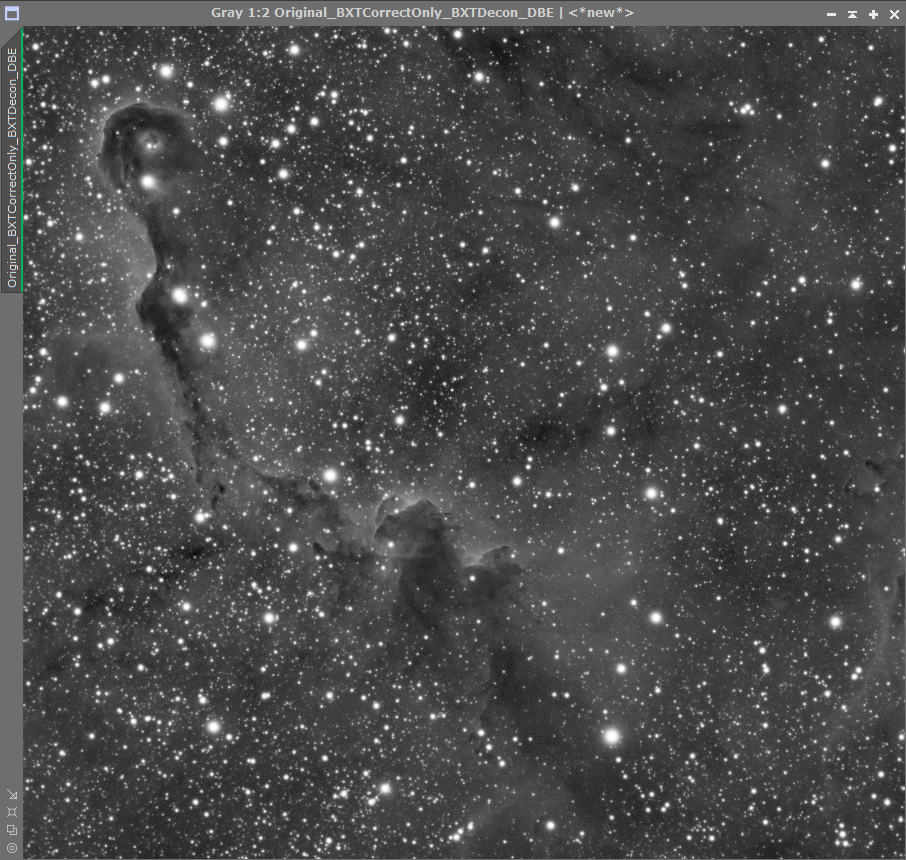 Here are the results with the various tools and settings, settings will be noted in the image identifier. I couldn't fit them all in the same preview image here, so I've paired each of them with the Starnet result as well as the original. The only thing changed after running each of the processes is the STF which was recalculated. Sorry if it gets long this way, but I figured this would probably be optimal: SXT Full vs Starnet:


SXT Lite vs Starnet  SXT Lite Nonoise vs Starnet: SXT Lite Nonoise vs Starnet:  As I see it the key feature is how SXT is handling star replacement. Starnet is clearly leaving a lot of spots behind which may be fine in the end result (I didn't go that far). Whereas SXT in its "full mode" is perhaps affecting small scale signal and the lesser options to a less degree of course since they are deisgned to run faster and with less functionality. I picked a couple of particular areas with some faint structures and performed an equal pixelmath stretch between all images (No other processing was done):     Given that this is only a simple pixelmath stretch I think they aren't too dissimilar. Looking very close you notice differences between all of these results and I would perhaps lean towards Starnet having a slight advantage while pixel peeping, especially in terms of small scale background details like those dark areas around the trunk. However in certain areas Starnet has failed to properly remove stars like here: 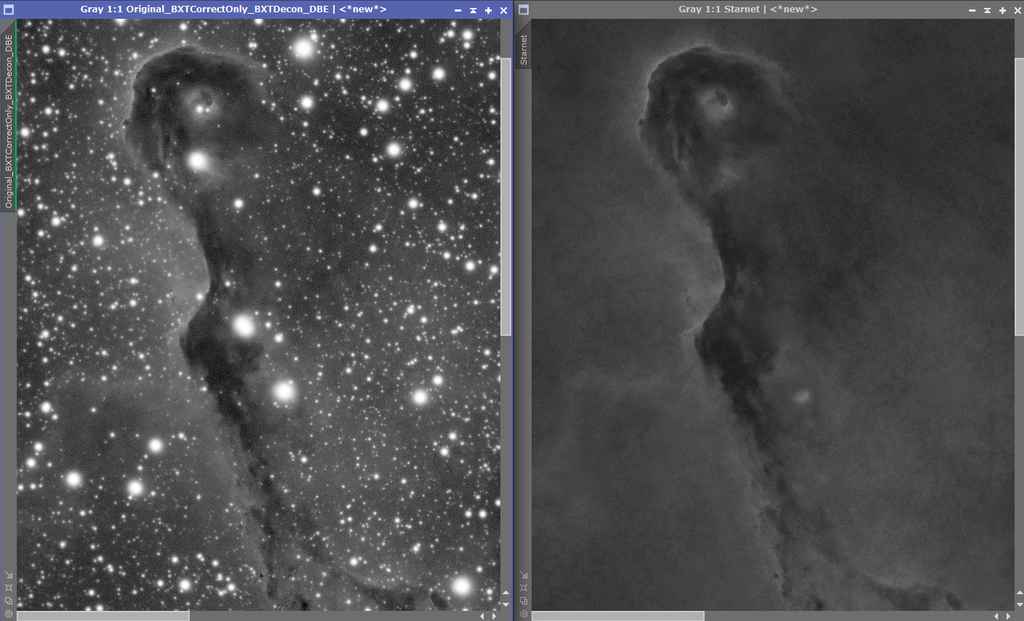 Here are some previews of the stretched images with the stars screened back in: Here are some previews of the stretched images with the stars screened back in:    At this point I'm less sure about Starnet. It looks a bit off in terms of how well the stars have gotten re-integrated as opposed to the SXT images. Those very small details gained in 2:1 view above have become even more miniscule:  Same images with a parse of NXT (0.25 NR and 0.15 detail): Same images with a parse of NXT (0.25 NR and 0.15 detail): I don't see any loss of larger scale signal like someone showcased in a previous post. While I haven't fully processed either of these images I'm tempted to say that in the end result I think you'll be hard pressed to notice much difference in details between any of these starless images. I think using SXT Lite (not the no noise AI) will probably be very close if not better than Starnet, while the full AI will probably smoothen things out quite a bit more. Here's a similar test conducted on a galaxy image, I tried cropping while including a number of smaller galaxies as well, the image was drizzled x2 in WBPP. Otherwise the same processes are run here as to the previous test image BXT with correct only first, then decon. At the end I did background extraction before proceeding with the star removal tools. The original image: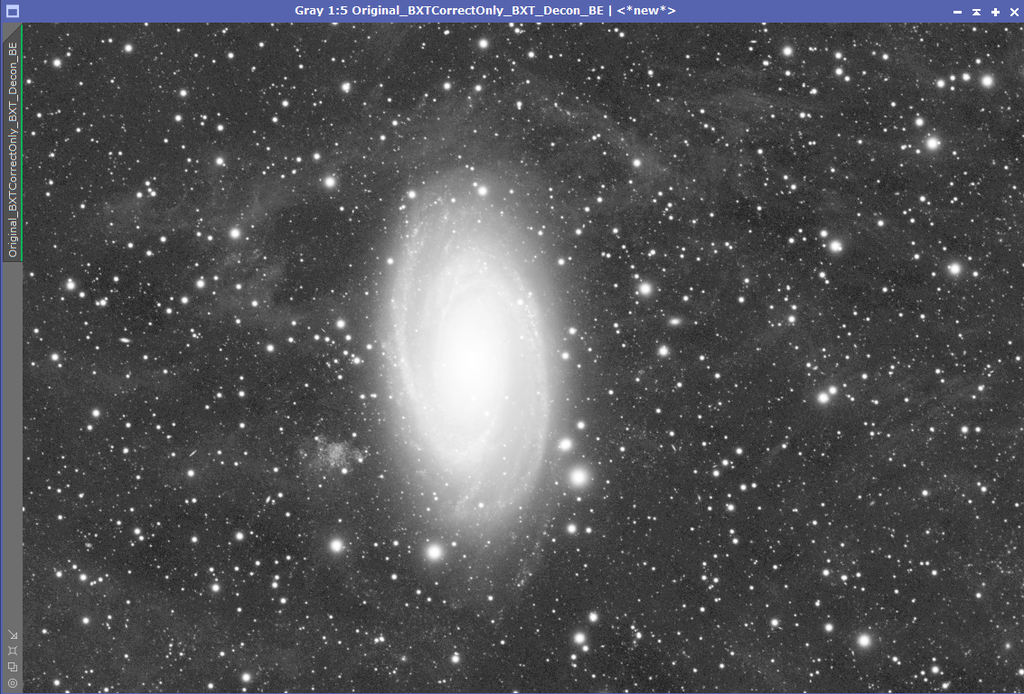 Here it becomes very interesting, very quickly. Already from the start I notice that Starnet is having big problems as can be seen below: SXT Full vs Starnet2:
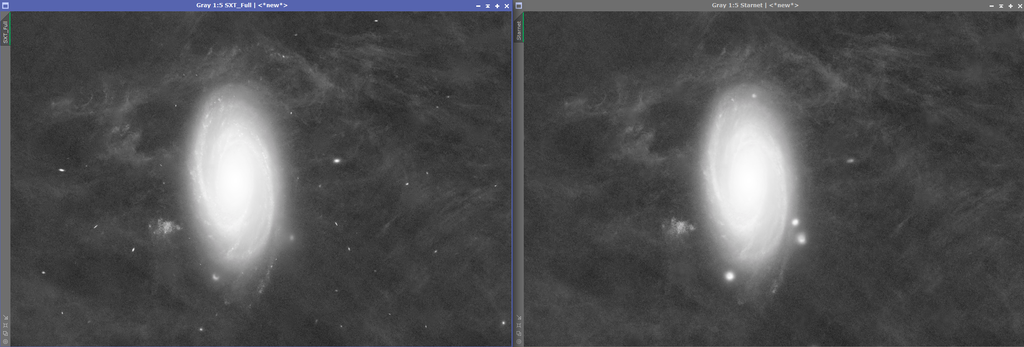 SXT Lite vs Starnet 2: SXT Lite vs Starnet 2:
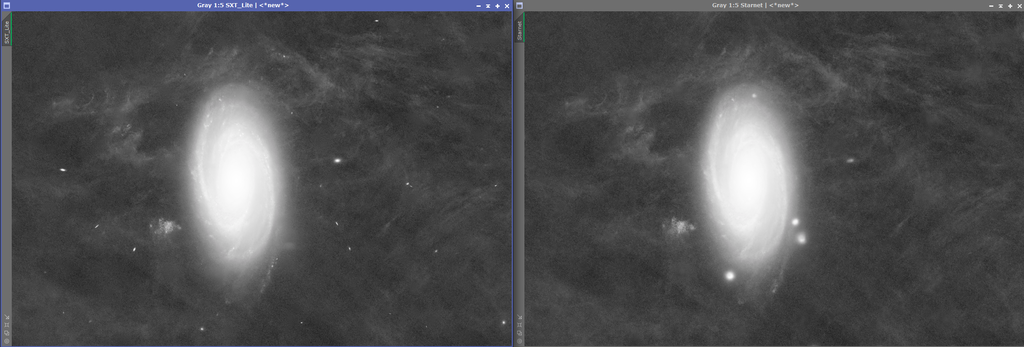 SXT Lite Nonoise vs Starnet2: SXT Lite Nonoise vs Starnet2:
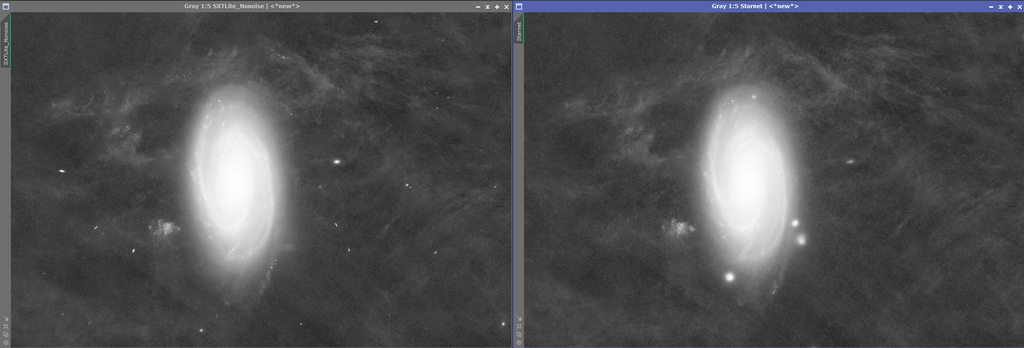 It's quite evident that Starnet2 has obliterated almost every single background galaxy in the entire image, while SXT in it's full AI mode has preserved the most. Starnet2 also have issues handling the larger stars in the image, some of which SXT also have slight issues with but not nearly as much. The two SXT Lite versions are handling those a lot better, but at the cost of background galaxies. Unfortunately PI crashed on me twice while I was bringing up the comparison images with a lesser applied STF to inspect the main galaxy. This only happened when I tried handling my Starnet2 image, each time. So I had to redo all of the images, but I kept the processes intact although the crop might have become slightly different. This shouldn't be an issue overall though as the most interesting thing in these images is the main galaxy itself. However I found that with the tighter crop SXT in its full mode now handled those big stars a lot better, go figure. I might also add that Starnet2 seem to also remove a lot of small details in the main galaxy itself. I noticed this immediately upon inspecting the first star mask it produced. All the nebulosity and highlighted details in general are gone, this did not change with the tighter crop. Original vs SXT Full vs Starnet: Original vs SXT Lite vs Starnet: Original vs SXT Lite vs Starnet: Original vs SXT Lite Nonoise vs Starnet: Original vs SXT Lite Nonoise vs Starnet: Disclaimer: Both of these images have a fair amount of data, the galaxy image definetly has a lot, the Trunk also have a reasonable amount. I have not tested how they handle lower SNR images. That wouldn't be very useful either. Disclaimer: Both of these images have a fair amount of data, the galaxy image definetly has a lot, the Trunk also have a reasonable amount. I have not tested how they handle lower SNR images. That wouldn't be very useful either. |
You cannot like this item. Reason: "ANONYMOUS".
You cannot remove your like from this item.
Editing a post is only allowed within 24 hours after creating it.
You cannot Like this post because the topic is closed.
Copy the URL below to share a direct link to this post.
This post cannot be edited using the classic forums editor.
To edit this post, please enable the "New forums experience" in your settings.






























